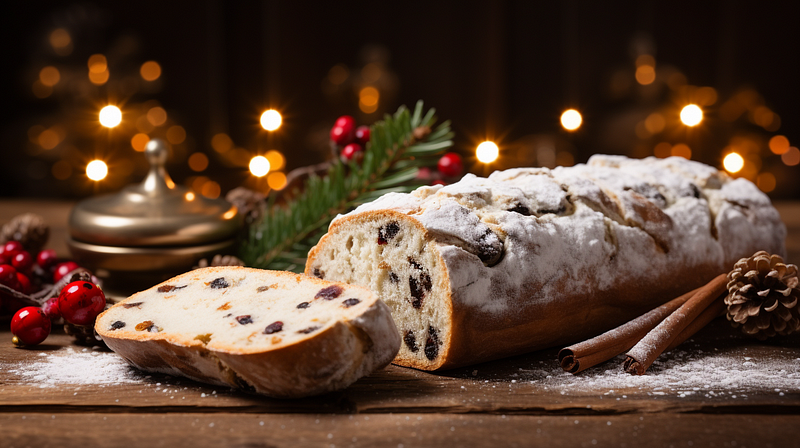Christmas Season: Traditional Food History
Christstollen
The German Fruit Bread of Christmas

The festive season heralds a time of joy, family gatherings, and, most importantly, the indulgence in traditional delicacies that have been passed down through generations. Among these, the Christstollen, a quintessential German fruit bread, stands out as a symbol of Christmas, intertwining rich flavors with a deep-rooted history.
Origin and Evolution: A Tale of Confectionery Artistry
Tracing back to the 14th century, the Christstollen’s origins are deeply embedded in the Christian traditions of Germany. Initially, it was a simple, austere bread made during the Advent period, adhering to the Church’s strict fasting rules. These early Stollens were void of butter and milk, resulting in a rather bland and hard bread.
The turning point in the Stollen’s history came in the 15th century when the Elector of Saxony petitioned the Pope to lift the butter ban during Advent. The Pope’s decree, known as the ‘Butterbrief’, allowed for the use of butter, transforming the Stollen into a richer, more flavorful bread. This pivotal change marked the beginning of the Stollen’s journey as a festive delicacy.
The Culinary Craftsmanship: Ingredients and Preparation
The modern Christstollen is a masterful blend of ingredients, each adding to the bread’s distinctive character. High-quality flour forms its base, to which yeast, milk, and butter are added, creating a rich dough. The heart of the Stollen lies in the generous addition of dried fruits like raisins, currants, and candied orange and lemon peel. Almonds and a mix of spices, typically cardamom and nutmeg, infuse the bread with warmth and depth.
The preparation of Christstollen is a labor of love. The dough, enriched with fruits and nuts, undergoes a slow fermentation process, which is key to developing its flavors. After baking, the Stollen is traditionally brushed with melted butter and dusted with a snow-like layer of powdered sugar, symbolizing the white robes of Christ.
Cultural Significance: More Than Just a Bread
In Germany, the Christstollen is not merely a bread but a symbol of Christmas itself. Its oblong shape, dusted with sugar, is said to represent the infant Jesus in swaddling clothes. This bread is more than a treat; it’s a part of the German Christmas ritual, with families gathering to savor it, often accompanied by a warm cup of Glühwein.

The city of Dresden is particularly renowned for its Stollen, hosting the annual ‘Stollenfest’. This festival celebrates the bread’s history and its significance to the region, featuring a giant Stollen that is paraded through the city and then ceremonially sliced and distributed among the people.
A Legacy Wrapped in Dough
The Christstollen’s journey from a humble, fasting bread to a symbol of festive abundance is a testament to the evolving nature of culinary traditions. It’s a story of adaptation, innovation, and the enduring power of food to embody the spirit of a season. As families across Germany and beyond slice into this rich, fruit-laden bread, they partake in a tradition that has sweetened Christmas celebrations for centuries. The Christstollen remains a cherished relic of history, a confection that sweetly binds the past with the present in every bite.
David Daniel, a food historian and avid traveler, dives deep into the world of gastronomy. His journey is a quest for understanding the full narrative of food — its cultural roots, ingredients, and evolution from the past to the future. David uncovers the rich, interconnected stories of global cuisines, with insights that bridge time and geography, offering a comprehensive perspective on the journey of food through the ages.
